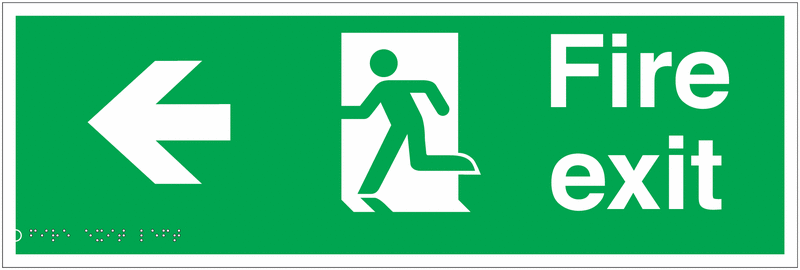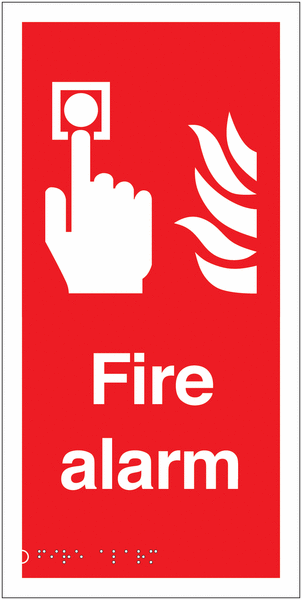-
Promotion

Fire Door Keep Shut - Braille Sign
£22.99
£21.03
Supplied in: Single -
Promotion

Fire Exit Arrow Right - Tactile & Braille Sign
£39.99
£35.09
Supplied in: Single -
Promotion

Fire Exit (Arrow Left) - Tactile & Braille Sign
£39.99
£35.09
Supplied in: Single -

Fire Extinguisher (Symbol) Sign - Tactile & Braille
£37.11Supplied in: Single -
Promotion

Fire Exit Keep Clear - Tactile & Braille Safety Signs
£22.99
£22.28
Supplied in: Single -
Promotion

Fire Exit (Arrow Up) - Tactile & Braille Safety Signs
£39.99
£35.09
Supplied in: Single -

Fire Alarm - Tactile & Braille Safety Signs
£37.11Supplied in: Single -
Promotion

Fire Exit Arrow Diagonal Right/Up Braille Safety Signs
£39.99
£35.09
Supplied in: Single -
Promotion

Fire Exit Arrow Left & Up Tactile Braille Safety Signs
£39.99
£35.09
Supplied in: Single -
Promotion

Fire Exit (Arrow Down) - Tactile & Braille Sign
£39.99
£35.09
Supplied in: Single -
Promotion

Fire Exit (Arrow Left & Down) - Tactile & Braille Sign
£39.99
£35.09
Supplied in: Single -
Promotion

Running Man Right/Arrow Diagonal Down Braille Sign
£39.99
£35.09
Supplied in: Single -
Promotion

Fire Exit (Running Man) - Tactile & Braille
£33.99
£29.66
Supplied in: Single
Fire Safety Braille Signs
Need help?
 Why are fire safety braille signs important?
Need Fire Safety Braille Signs? Get the UK's Best
Why are fire safety braille signs important?
Need Fire Safety Braille Signs? Get the UK's Best
In the event of an emergency, it is important that everyone on site is able to exit the area safely and quickly – including anyone who may have limited vision. Braille emergency signs are essential to ensure that visually impaired staff, customers or visitors are prepared for emergency situations. Seton carries a complete range of fire exit signs in braille, so you can choose the most effective signs for your workplace needs. Browse through our complete range of braille exit signs, fire alarm and fire extinguisher tactile braille signs to find the signs that work best for your business.

Expert Information
Fire safety braille signs
According to the NHS, there are almost two million people living in the UK today with sight loss. Out of these two million people, around 360,000 people are registered as being blind or partially sighted.
In the event of an emergency, it is of utmost importance that everyone is able to exit the premises safely, especially anyone who has vision impairment or loss and therefore is more vulnerable. The use of well-placed signage with braille makes the worksite a safer, more inclusive place for everyone.
Choosing the right exit sign with braille
Seton has a complete line of Fire Safety Braille Signs, including exit signs, fire door signs and fire exit signs for the visually impaired. After performing a full risk assessment to better understand the safety risks and hazards in a workplace and deciding on the best emergency routes possible, you will know which signs will be needed to properly guide everyone on the worksite to the nearest exit. Our fire exit signs helpfully come with a variety of arrows pointed in different directions so you can build an evacuation route throughout the worksite that is properly demarcated.
Seton also has a range of signs for marking out specific areas, along with the appropriate tactile exit signs. These include Fire Exit (Running Man), Fire Exit Keep Clear, Fire Door Keep Shut, Fire Alarm and Fire Extinguisher (Symbol) signs. This range of signs will help you to build a well-marked evacuation route and also mark out important safety features such as fire doors, fire extinguishers and alarms.
All of Seton’s fire safety braille signs are easy to install and are highly durable. The signs are made from one-piece, die-molded plastic, so the printing underneath is protected. They can be easily and quickly mounted in both indoor and outdoor environments. Some of our signs also have a self-adhesive backing which makes mounting the signs especially simple and quick. It is important to first ensure that the area is clean and dry, before installing a sign.
All of the signs are in Grade 1 braille, which is the most widely used grade of braille. The symbols indicated on the signs also all conform to ISO 7010 to ensure that you are compliant with the latest safety measures in place. It is important to add that braille fire exit signs cannot be used as the only means of alerting or directing a person with impaired sight during an emergency.
FAQ's
What is braille signage?
According to the NHS, braille is a writing system in which raised dots are used as a substitute for written letters. People who have severely impaired vision or vision loss often learn to read braille using their fingers. Braille door signs allow those with vision loss to read what the sign says.What does the law say?
In the UK, the responsibility for employee and workplace safety rests with the employer. It is important for both worker safety and employer liability to ensure that all safety guidelines and measures are followed in the workplace – this also applies to signs for visually impaired. According to the HSE guidelines on safety signs and signals in the workplace, it is the employer’s responsibility to ensure that the premises has all of the required safety signs properly placed and maintained.What are braille signage requirements?
By installing tactile signage in the workplace, you are also complying with the Disability Discrimination Act 1995 and you are taking steps which the Local Government Management Board and the Departments of Environment, Employment, Education and Social Services consider a reasonable adjustment, according to the DDA.If you are interested in learning more about how you can make your workplace a safer and more inclusive place for people with sight loss, the Royal National Institute of Blind People (RNIB) has a number of resources specifically for businesses. This includes resources on how to support blind and partially sighted customers and ways to increase accessibility.
What is the best placement for braille signs?
Placement is a very important consideration when mounting braille signs for fire exits. As the signs will also communicate fire safety information for sighted employees, it is important that the signs are placed in highly visible locations.However, as people with sight impairment need to touch and feel the signs in order to read the braille, it is important that the signs are not mounted too high up on a wall, which would make them inaccessible. The UK Sensory Trust has additional information regarding optimal braille sign placement areas and heights.
It is important to also ensure that all braille emergency signs are well maintained as damaged signs may be illegible for both sighted and non-sighted individuals. Braille emergency signs should be checked regularly to ensure that they are in good condition, especially if they are placed outdoors as they could be exposed to adverse weather conditions and vegetation, which can damage the signs.
Where is braille signage required?
When considering health and safety in the workplace, it is important to review all relevant legislation and guidelines when deciding which braille signs are needed for your worksite’s particular needs. There are a number of resources available in the UK to help you determine where braille signs are needed, including the Sensory Trust, the Disability Discrimination Act 1995 and the Equality Act 2010.As with all safety equipment, one of the most important things you can do to improve the safety of your worksite is to ensure that all of your employees are trained on what to do in the event of an emergency, and that they are aware of the emergency routes to take that will lead them out of the premises quickly.
As part of their emergency response training, employees should also be informed of what to do when there is an emergency and someone with sight impairment or another disability is on the premises. Should an emergency situation occur, employees therefore will know what to do if there is a disabled individual on the premises, and how they can best help them to evacuate the area.




